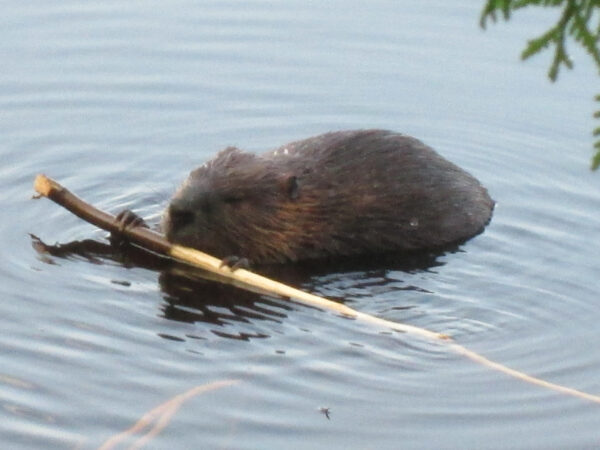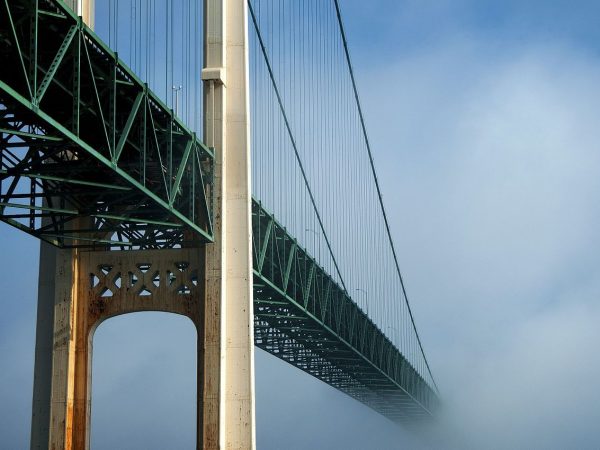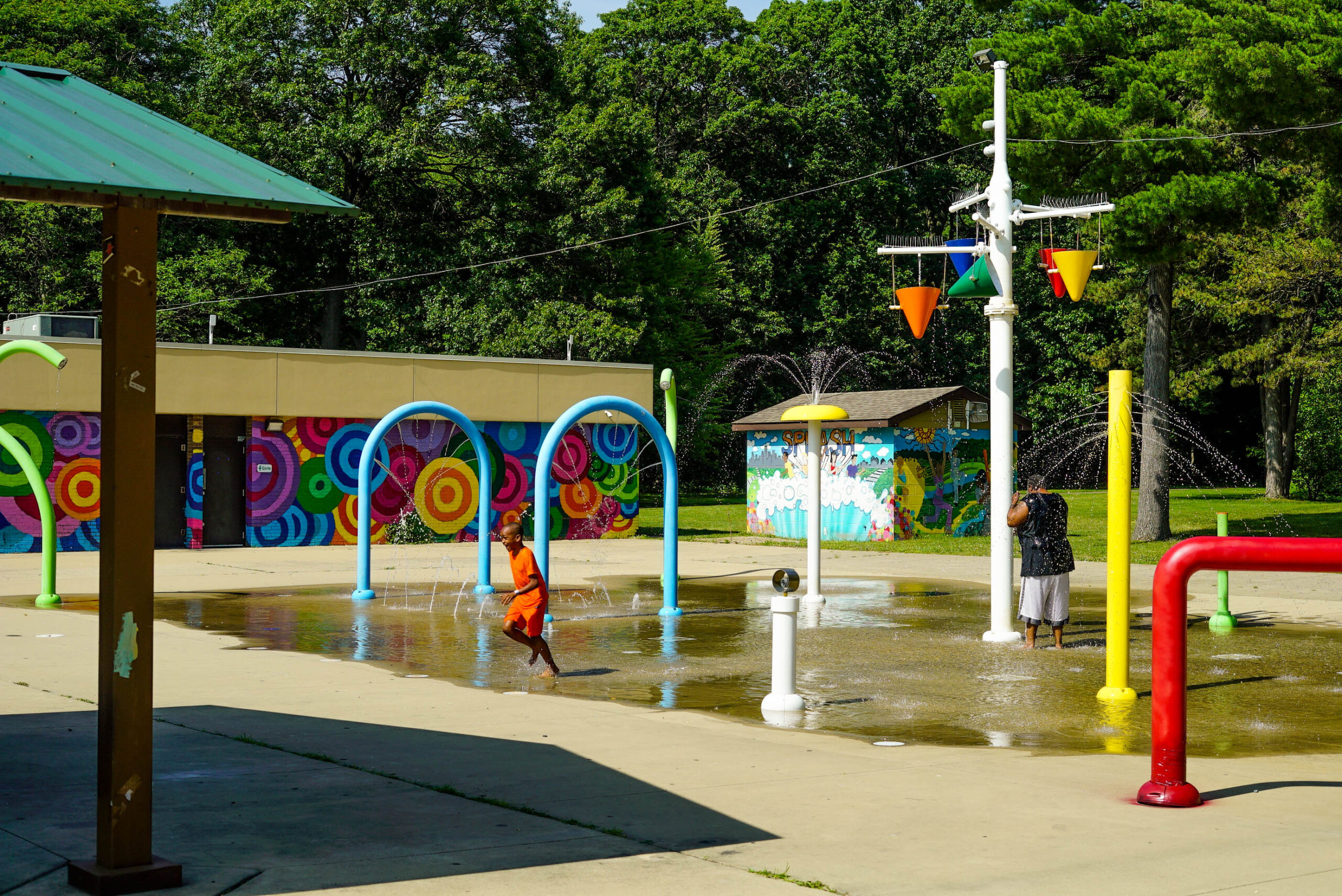
This is the second half of a series on heat islands around the Great Lakes. Part one is on the human health cost. Part two is on the science behind combating the urban heat island effect, solutions to the complex problem, and the role the Great Lakes play.
Three blocks from the Detroit River, on the corner of East Jefferson Avenue and Chene Street, there’s a Concentra Urgent Care. It’s located in a strip mall with a Bank of America, BP gas station, 7-Eleven, and a few small restaurants.
There are little trees planted around the edges of the parking lot, but in the late afternoon, only a handful of parking spaces outside the urgent care are shaded by these smaller trees. These cooler spots are all taken. Two cars have their windows down and their ignitions off — while people are either lying in the back or sitting and waiting in 78-degree heat, that maybe feels more like the mid-80s.
Last year, data from Climate Central showed that 86% of Detroiters are exposed to temperatures at 8 degrees or higher (sometimes 15 to 20 degrees higher in the mid-afternoon) than the city’s suburban neighbors. This is the highest percentage of residents that Climate Central discovered are impacted by the urban heat index. Even more of the population than in other larger cities that deal with even warmer temperatures, like New York, Houston, Los Angeles, Dallas, and Phoenix.
Across the street from Concentra Urgent Care, there’s another parking lot next to a used car shop. In the late afternoon, the shop’s cement brick building provides some shade for a row of empty parking spaces. Though, there’s something else working to cool this easily overlooked environment. The asphalt slopes at an angle from the edges of the lot and down toward the center, where there is a large patch of greenery. Underneath this verdant rectangle is a French drain that catches the rainwater and stores it, so the vegetation always has plenty to drink.
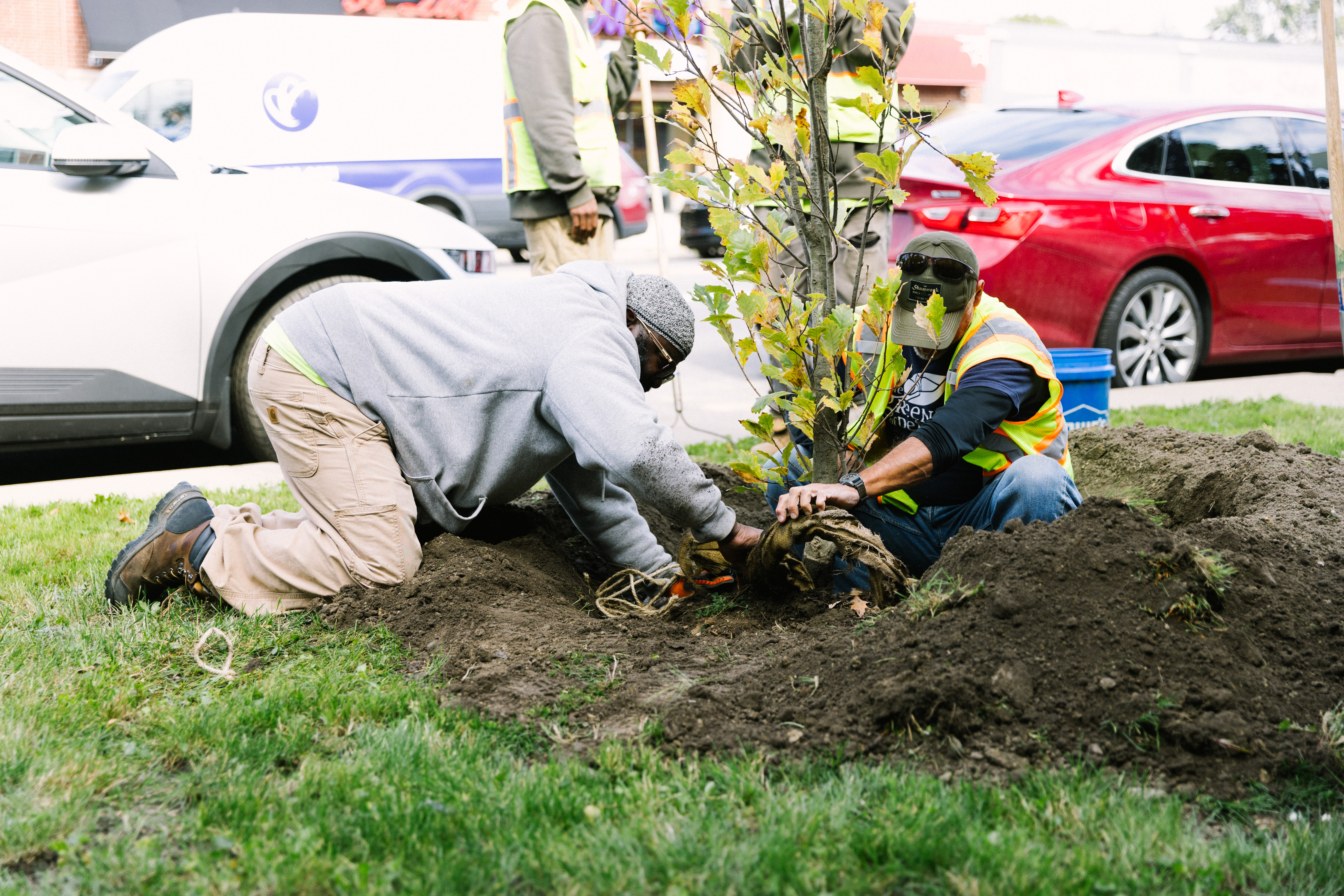
In 2022, Mayor Mike Duggan and U.S. Sen. Debbie Stabenow joined American Forests, DTE Energy, Detroit Future City, and The Greening of Detroit for a joint initiative to plant more than 75,000 trees, employ over 300 Detroit residents in tree care and maintenance, and invest $30 million in Detroit neighborhoods. This is a five-year project to beautify Detroit while protecting residents who are at risk from extreme heat. (Image courtesy of the city of Detroit)
These newly planted trees will one day tower over the surrounding tall grasses and plants to provide even more shade for this lot, according Keenan Gibbons, who was tasked with designing this public space. The way behavioral decisions interact with city infrastructure is something Gibbons considers for a living as a licensed landscape architect and urban design professional — who also utilizes his Federal Aviation Administration (FAA) Remote Pilot license to conduct heat island research. According to Gibbons, water plays an essential role when planting trees, adding green infrastructure like permeable pavement, and creating more green spaces around a city to cool it down in the long-term. This is because of something called transpiration.
“If you’re in the middle of summer, and it’s really hot, and you’re in a pool, and you jump out of the pool, for the very first minute or so you feel very cold, even if it’s 90 degrees outside,” said Scott Sheridan, an expert in bioclimatology. “And the reason you feel cold is because what you have going on is the energy is evaporating the water off of your skin. And that requires energy to go into the water for phase change. And so, your skin gets colder momentarily, and you feel cold.”
Trees and plants do the same thing, which is why most cities are investing in adding more green space. Vegetation can cool an environment when there is enough ground water to evaporate through their leaves. When there isn’t enough ground water or greenery, that energy is used to create sensible heat. Construction workers, laboring in cement and asphalt laden heat islands, are among the most vulnerable to sensible heat during summer months.

This image shows how highly developed urban areas (like on the left) have less moisture available for evapotranspiration because they are mostly made up of impervious surfaces, like concrete and asphalt, contributing to higher air and surface temperatures. The image on the right shows the contrast of how vegetation aids in cooling the immediate environment with evapotranspiration. (Image courtesy of the EPA)
With climate change creating more extreme weather patterns, swinging from freezing cold to very hot can be dangerous for the body. That is why these transitional seasons like spring and fall are crucial for preparing the body for both extremes. According to emergency room physician, Dr. Patrick McHugh, the body is most comfortable at our average body temperature, “it’s where your body has found its happy place.” Once the atmospheric temperature gets too high, that is when things start to get tricky.
Though the cities of Cleveland, Chicago, Detroit, Milwaukee, Windsor, and Toronto are all urban heat islands, their proximity to the Great Lakes is to their advantage, according to physical geographer Dr. Woonsup Choi of the University Wisconsin-Milwaukee. Choi recently compared the urban heat island impact of Minneapolis, Minnesota to Milwaukee, Wisconsin and found that Milwaukee’s proximity to Lake Michigan slightly lessened the extreme heat effect for some the city’s neighborhoods.
The main problem for cities along the lakes is in how they were built. Many of the downtown areas are located close to the water, meaning these taller buildings act as a wall, preventing the cool air that comes off the lake — known as “lake effect” — from coming further inland. Humidity is also a factor that many experts said needs to be studied further, as the summer air can get quite thick and moist in the Great Lakes region, which can make it difficult for certain people to breathe (like those with asthma and COPD).
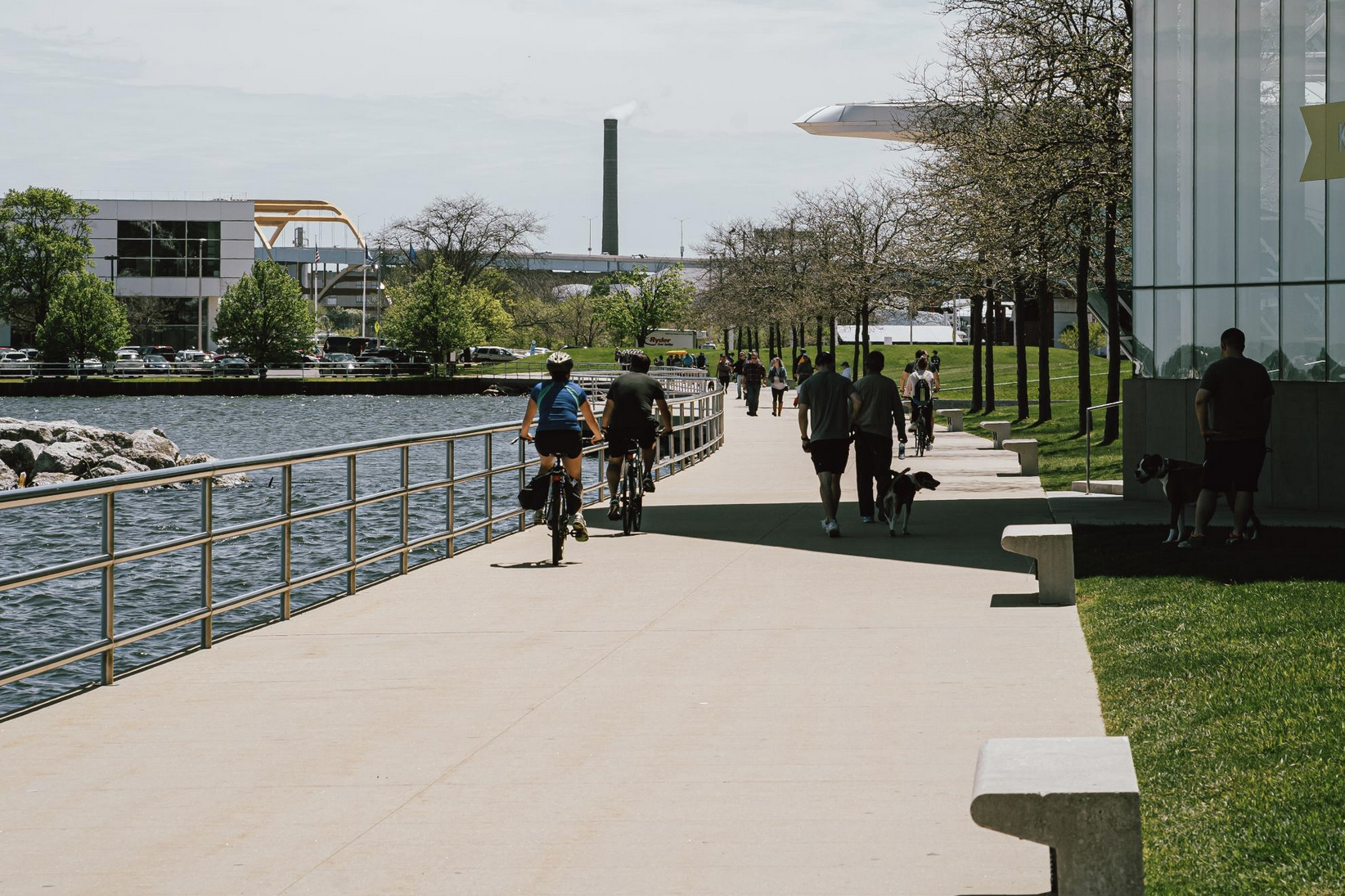
In 2014, Milwaukee installed its nonprofit bike share system, Bublr Bikes. Residents are encouraged to bike along the lakefront, heading downtown to Veterans Park or accessing the lush, cool greenery of Oak Leaf Trail. Bicycles help reduce the need for parking lots, which are often made of materials that worsen a city’s experience with heat. (Image courtesy of the city of Milwaukee)
Choi said these cities have unique opportunities to create more public parks or beaches along the water, so that people can venture there to cool down. Aletha Acree, a lifelong resident of Cleveland living with Lupus, said she wishes the city of Cleveland would put more money into permanent shelters for shade on public lakefront areas. As well as, invest in regularly cleaning the water and beaches, as she often finds rats and trash — not making it the most welcoming environment. Chicago nurses at The Night Ministry, Stephan Koruba and Summer Kee, wish the city would make getting to Lake Michigan more accessible. Kee suggested that perhaps the city could provide free train or bus fare for those dealing with housing insecurity or living under the poverty line — who especially need to experience the cool breeze from the lake effect on the hottest days of the year.
“We have a lot of clients who ride the CTA [Chicago Transit Authority] consistently, so making the CTA more accessible for our clients, making it less difficult to get a ride-free card, so they could hop on the bus, so they could hop on the train, because if they were allowed to come and go, then maybe they wouldn’t feel necessary to never leave the train, maybe they would come and go more freely,” said Kee about their patients, some of whom are part of the unhoused population of Chicago. Kee added that the city is not not gaining any money from these folks who are on the train all the time, and how the city could lessen the burden of the whole system by letting people come and go more freely, by making it easier to issue ride-free cards.
Kee went on to explain how a lot of their unhoused clients struggle to find available beds in the summer in part because the city of Chicago has a mandate that demands shelters have more beds available in the winter. This comes back to cultural orientation to heat and weather, as the Great Lakes region is more used to dealing with dangerous freezing temperatures. Now, with the current heat wave in effect for most of the region, city officials are tasked with getting creative — and fast — when it comes to ensuring all residents are safe during these extreme fluctuations in temperature.
In Toronto, over 100 buildings are utilizing cold water from the bottom of Lake Ontario to cool down. According to Jeffrey Brook, the Deep Lake Water Cooling System is a great example of how Canada has prioritized to “green” their energy. Canada is soaring ahead in terms of their energy transition away from coal and gas, with 82% of their electricity coming from hydro, nuclear, solar, and wind. However, according to Brook, Canada has been extremely behind in terms of data and research on the topic of environmental health.
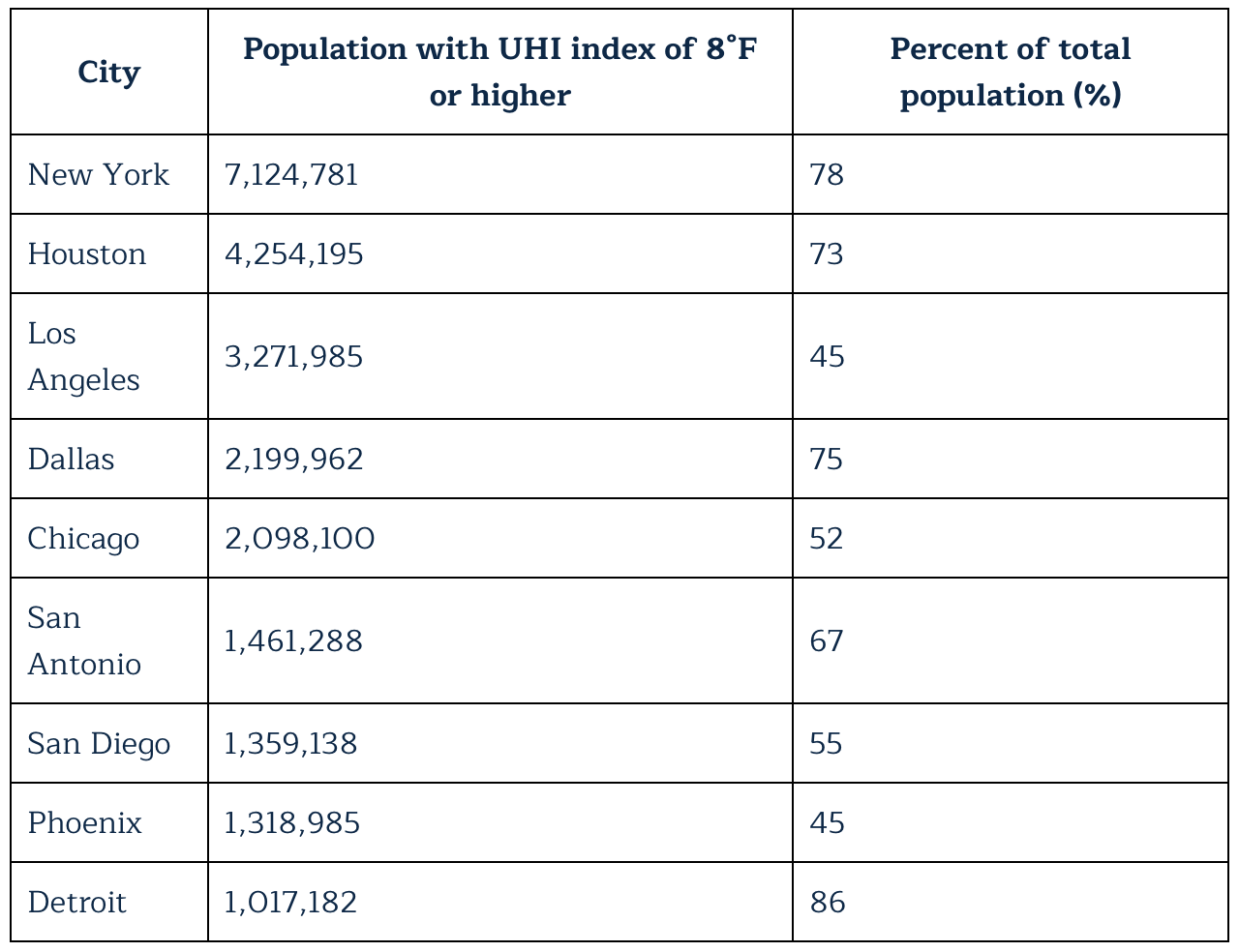
According to 2023 data from Climate Central, “more than two-thirds of residents in the following cities experience at least 8°F more heat due to the urban heat island effect.” (Image courtesy of Climate Central)
In November 2023, Brook and his colleagues launched HealthyPlan.City, which came from a project he started in 2016 called the Canadian Urban Environmental Health Research Consortium, or CANUE. According to Brook, the United States has the National Institutes for Environmental Health Science where a tremendous amount of research is done on environmental health issues. However, he said, Canada hasn’t really had anything like that. So, CANUE started as a way to really accelerate research around environmental health.
“You know, as the mantra goes – next to your genetic code, the next most important thing to determine your health is your zip code, or postal code,” said Brook.
HealthyPlan.City brings an enormous amount of health data and variables to Canadians impacted by these issues the most. Want to see where children in Windsor might be impacted by a lack of tree canopy cover? Toggle a few buttons to change the metrics and see how something is impacting someone; ranging from air pollution or flood susceptibility, from first generation immigrants to newly arrived immigrants — it’s a stunning example of making complex data accessible.
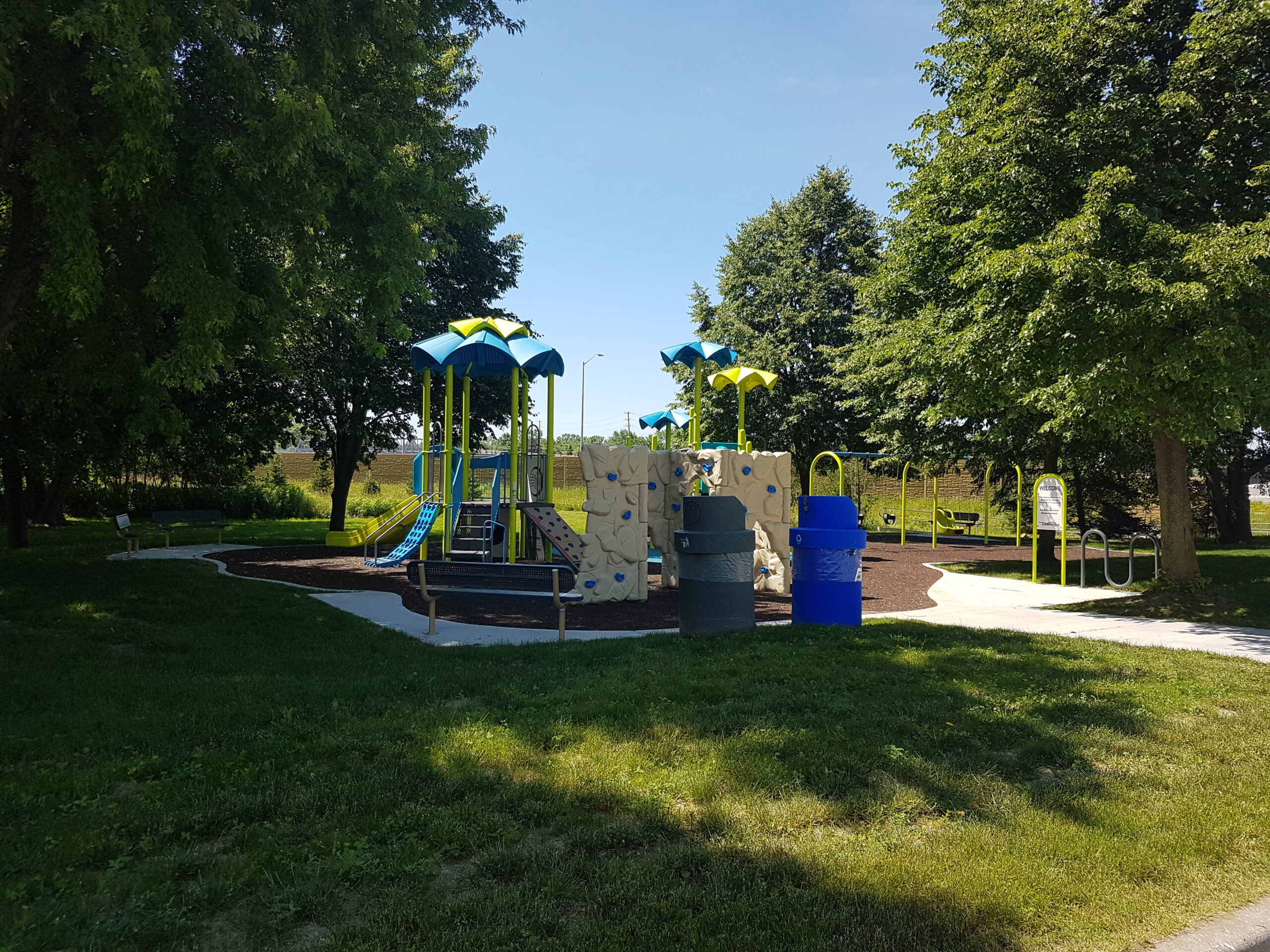
This shaded playground at Marguriet Park was installed in 2019. The City of Windsor is in the process of developing an Urban Forestry Management Plan — which aims to address the urban heat island effect. (Image courtesy of the Windsor Parks Department)
According to Brook, only a few months after the launch of HealthyPlan.City, activists in Montreal used the data from this project to propel protests around preventing a road from being built through Boisé Steinberg, a local forest. This came after 66 people died in a heat wave in Montreal (also known as a heat island), in 2018. Community involvement around heat island research is something Ralph Cintrón is doing in Chicago with Community Research on Climate and Urban Science (CROCUS), a Department of Energy project led by Argonne National Laboratory.
“At some point, she says, ‘everywhere I’ve moved, seems to have been hotter than the last place,’” said Cintrón about a community member he and his colleague interviewed as part of this project. “And what I’m thinking about is, that makes sense to me. Because what she’s essentially saying is that ‘I lived in a part of the city. Then it started to get gentrified. So, I had to live in another part of the city, then that got gentrified. Then I had to live in another part of the city, and that got gentrified.’ You see what I mean. Kind of like the story of poverty.”
Cintrón acts as a representative on behalf of the Puerto Rican community for CROCUS through the Puerto Rican Agenda, Climate Change Committee. The neighborhood of Humboldt Park is known as one of the most intense heat islands in the city of Chicago and is home to mostly Hispanic families. One of Cintrón’s favorite projects with CROCUS has been working with teenagers who are gathering data using Argonne’s equipment. The whole project is about gathering data, making sense of the information, and getting it into the hands of the population that is most impacted by heat in the city. To Cintrón, this is a kind of social transformation.

On July 28, 2023, the city of Chicago created a team of resident-volunteer scientists to measure heat across different communities for a National Oceanic and Atmospheric Administration (NOAA) project. Some of the factors measured were tree coverage, air flow, heavy traffic, humidity, and the density of buildings and concrete. (Image courtesy of the Chicago Department of Public Health)
Argonne National Labs has also been working to build more data models that detail the way freshwater works in relation to the unique weather patterns around the Great Lakes region. Dr. Jiali Wang, an atmospheric scientist in the Environmental Science Division at Argonne, wanted to study the contrasting effect of the lake, specifically the lake breeze and the heat stress due to the urbanization, and how they compare with each other. What was most shocking was that a model for this didn’t already exist, but she said this is because the Great Lakes region is very unique.
“Water compared with the atmosphere, it has a longer memory,” said Wang. “It gets warmer or cooler, much slower because it has a huge capacity.”
She gives an example: think about how long it takes to warm up a plastic pool. The parents inflate it in the morning and put the water there, but they won’t ask kids to play in it until afternoon because it takes that long for the water — the whole little pool of water — to heat up to something comfortable. Then, she says, think about the Great Lakes and how big they are and how long it would take to make them completely warm or cold.
She said the lakes have this big capacity which makes it harder to make temperature changes, but once they make these big changes — it also takes a long time to change it back. Given how much the region relies on the lakes to keep cool in the summer, this is why lake warming should also be a top priority when combating heat islands around the region.

The City of Windsor has built over 20 shade structures and four Splash Pads, and it has added drinking water fountains to help reduce the risk of extreme heat for visitors. This shade canopy was installed at Marguriet Park, in 2018. (Image courtesy of the Windsor Parks Department)
“This is a great intersection with water quality, if you’re right by a giant lake,” said Becky Rose, geographer from University Wisconsin-Madison, about things to consider when utilizing water to cool Great Lakes populations living in heat islands. “Where you are, is it safe to swim? Do you have algal blooms? Do you have pollution? Like, what is the situation or can you buffer that with swimming pools and such. And finally, water features can really make a big difference with comfort like splash parks for kids or whoever, or misting fans, fountains.”
Rose went on to suggest turning libraries into cooling centers, and suggested paying librarians more so that these public spaces could be open later. The possibilities of how these cities around the Great Lakes could adapt and change when considering not just climate change, but also the comfort and enjoyment of its residents, is endless. According to Rose, these cities just need to get on board with short-term goals as well as continuing to add more trees and green spaces.
Great Lakes Now reached out to city officials in Chicago, Cleveland, Detroit, Milwaukee, Windsor, and Toronto. Read their full statements on what they are doing to combat the heat island effect in their cities.
Correction: An earlier version of this article stated Community Research on Climate and Urban Science (CROCUS) is an Argonne National Laboratory project, when it is actually a Department of Energy project led by Argonne National Laboratory.
Catch more news at Great Lakes Now:
Looking for a US ‘climate haven’ away from heat and disaster risks? Good luck finding one
As Great Lakes warm, collaboration and Indigenous self-determination are keys to adapting
Featured image: On a hot afternoon, a young family has fun while cooling off at the splash pad in Detroit’s Palmer Park. Experts say that having a splash pad within walking distance can vastly improve the quality of life for many city dwellers. They are also more environmentally friendly as water is stored in underground tanks that can be recycled back through the splash features or to water nearby vegetation. (Photo Credit: Lisa John Rogers)



